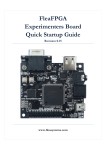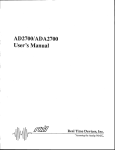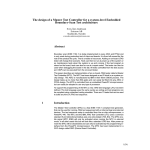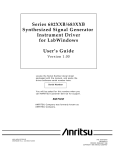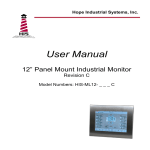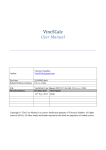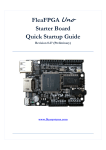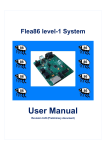Download Sweet32 Minimal-RISC User Manual
Transcript
Sweet32 Minimal-RISC User Manual By Valentin Angelovski (c) 2014-2015 Release date: 28th-February-2015 (Preliminary) Release version: 0.95 What is Sweet32? Sweet32 is best described as a ‘no-frills’ 32bit minimal-RISC microprocessor core with a load/store register architecture with a simple bus interface. Originally started as a means towards learning VHDL, Sweet32 has evolved into a reasonably low-gatecount CPU that can be used for learning or even real-world applications. Typical Sweet32 logic utilization, on the Lattice MachXO2 FPGA (for example), is 842 LUT4 elements in a standard configuration and area-optimized form. Sweet32 was written in VHDL and is released under LGPL 2.1 Sweet32 Architecture Summary • • • • • • • • • • • 16x32-bit General Purpose CPU registers Little-endian architecture 27 Instructions, focussed mainly on 32bit and 16bit data processing 16x16-bit multiplier standard, with optional 32x32-bit multiplier support Conditional branch/compare opcodes, with no Status flags register Completely register-based CPU, with no hardware stack pointer Unaligned data access support for 8 and 16bit data. (32bit data must be 16bit word-aligned) Single-cycle external IRQ channel 32bit internal data-path and 16bit Data external bus Basic Trace/debug interrupt support included Simple to implement and/or emulate! Sweet32 CPU Block Diagram Program Counter Reg Z Reg X ALU Reg Y Fast IRQ and trace support CPU Reset Logic 32bit x 16 General Purpose register file D31-D0 32bit to 16bit bus converter A31-A0 System timer D15-D0 mem_read_o mem_write_o Instruction Decoder RAM/ROM D15-D0 Bus_wait IRQ0 rst (reset) clk1 (BIU_clk/4) Peripheral Bus Interface Unit ADC/PWM To GPIO etc. Interrupt reset clock CPU Core Registers Description Sweet32 is composed of the following core registers: R0-R15 General Purpose Registers (Direct Read/Write) These registers are all directly accessible by the programmer for the purposes of logic and arithmetic processes, as well as temporary variable/constant/pointer storage. It is the responsibility of the programmer to initialize these registers upon power-up as they are not cleared upon reset and will contain undefined values. PC Program Counter (Direct Read/Indirect Write) This register is used to store the address of the current program instruction being pointed to. Please note that as Sweet32 instructions are mostly 16-bits wide, every program counter increment represents one 16-bit instruction or data word currently being accessed. Consequently, all Sweet32 programs must be 16-bit word-aligned. Upon Sweet32 reset, program execution begins from location zero (i.e. 0x00000000) Program counter is directly readable only via the GETPC instruction and can be indirectly written to using the LJMP instruction. IRQ0VEC IRQ0 Interrupt vector address (Direct Write-only) This register stores the absolute 32-bit address of the user IRQ0 handler routine. Upon the receipt of a valid IRQ event (i.e. logic high or ‘1’), the program counter register is preserved and then the new value stored in this register is loaded. This causes the Program counter to effectively jump straight to the specified start address of the IRQ0 handler for processing. IRQ0_RTN IRQ0 Interrupt return address (Not accessible) This register is used internally by Sweet32 to store the return address of the IRQ interrupt cycle. When the IRQ handler routine has ended with the RETI instruction, the program counter is then re-loaded with the value previously saved in this register and main program execution continues as per normal. TRACE_RTN Trace Interrupt return address (Direct Read-only) This register is used by Sweet32 to store the return address of the Trace/Debug interrupt cycle. When the trace/debug routine has ended with the RETT instruction, the program counter is then re-loaded with the value previously saved in this register and (if the trace interrupt is no longer enabled) main program execution then continues. This register is accessible to the programmer using the GETTR instruction. CW CPU Control word (Direct Write-only) This register controls the external event handling capabilities of the Sweet32 Microprocessor. By setting the appropriate bit location to ‘1’ the specified function is enabled, while clearing the bit disables the function. Upon reset, the control word register is completely set to zero (ie all external event handlers are disabled). Control Word (CW) Register usage: Bit 31 = trace/debug enable XR Bits 30 to 1 = Reserved for future use Bit 0 = Interrupt IRQ0 enable **OPTIONAL** 32x32 Multiplier upper 32-bit result (Read-only) When implemented (normally it is NOT present in the standard Swee32 CPU config.), this register holds the upper 32bit result of an extended 64bit math operation (i.e. 32x32bit multiply). This register is accessible only using the (also optional) ‘GETXM’ opcode and must be executed immediately after a MUL opcode. Sweet32 instruction encoding Most Sweet32 opcodes are fixed 16-bit* organized in the following typical format: Bits 15 downto 12 Opcode select Sweet32 Instruction 16-bit word format Bits 11 downto 08 Bits 7 downto 4 RegY_select RegZ_select Bits 3 downto 0 RegX_select * = Some opcodes, like LDD, LDW and MJMP will require an additional word or two to fully encode their data (see next section). Note also that all instructions must be 16-bit word-aligned and all 32-bit data must be represented in big-endian format Instruction Set Summary: Topmost-Nibble Encoding: Sweet32 Instruction: Instruction operands: 0000: 0001: 0010: 0011: “ 0100: 0101: 0110: 0111: 1000: 1001: 1010: " " " " " 1011: 1100: " " 1101: " 1110: 1111: AND ADD XOR TST(SNZ/SZ) BIT(SNZ/SZ) SUBSLT MUL/GETMX** SJMP LDB MJMP GETPC LDW/D SETIV RETI SETCW RETT GETTR INCS SWAP(B/W) NOT LJMP LSR ASR MOV(W/D) MOV(W/D/SW) Rz,Rx,Ry Rz,Rx,Ry Rz,Rx,Ry Rx,Ry Rx,#imm5 Rz,Ry,Rx Rz,Rx,Ry / Rz #rel12 Rz,#imm8 #rel28 Rz, #imm8 Rz,#imm16 Rx Rx Rz Rz,Rx,#signed_imm4 Rx Ry,Rx abs32 Rx Rx Rx [Ry],Rx Ry,[Rx] Instruction Cycles*: 1 1 1 1 1 1 1/2 1 1 2 1 3/4 1 1 1 1 1 1 1 1 1 1 1 3/4 4/5 Note: * = While Sweet32 is 1T capable, it is heavily dependent on Bus Interface Unit (BIU) implementation for best performance. As supplied with, this project, the BIU is greatly simplified in that it uses no pipelining or multi-phase clocks, but it does feed the Sweet32 CPU a divide-by-3 clock, thus making it technically a 3T system. Future Sweet32 releases may also include a 1T BIU variant. Note: **= GETMX opcode is designed to be used with the MUL opcode when the 32x32 multiplier configuration is enabled in the Sweet32 VHDL module, please refer to the MUL opcode instruction description for further details. Sweet32 Instruction Set Description "AND Rz, Rx, Ry" Boolean AND Takes the logical AND of Rx, Ry and stores the result into Rz Encoding = 0000 + Ry_addr + Rz_addr + Rx_addr "ADD Rz, Rx, Ry" Unsigned addition Performs a 32bit unsigned binary addition of Rx, Ry and stores the result into Rz. Encoding = 0001 + Ry_addr + Rz_addr + Rx_addr "XOR Rz, Rx, Ry" Boolean XOR Takes the logical AND of Rx, Ry and stores the result into Rz Encoding = 0010 + Ry_addr + Rz_addr + Rx_addr "TSTSZ Ra, Rb" Boolean AND test and skip if zero Performs a logical AND of Rx, Ry and skips the next program location if the result was zero. Result is NOT saved but is discarded. Encoding = 0011 + Rx_addr + 0100 + Ry_addr "TSTSNZ Ra, Rb" Boolean AND test and skip if NOT zero Performs a logical AND of Rx, Ry and skips the next program location if the result was NOT zero. Result is NOT saved but is discarded. Encoding = 0011 + Rx_addr + 0000 + Ry_addr "BITSZ Ra, #imm5" Boolean single-bit AND test and skip if zero Performs a logical AND on a desired bit within Rx and skips the next program location if the result was zero. Result is NOT saved but is discarded. Encoding = 0011 + Rx_addr + 1100 + #imm5 (selects Rx register bit to test from 0 to 31) "BITSNZ Ra, #imm5" Boolean single-bit AND test and skip if NOT zero Performs a logical AND on a desired bit within Rx and skips the next program location if the result was NOT zero. Result is NOT saved but is discarded. Encoding = 0011 + Rx_addr + 1000 + #imm5 (selects Rx register bit to test from 0 to 31) "SUBSLT Rz, Ry, Rx" Unsigned subtraction and skip if Ry < Rx Performs an unsigned subtraction ie. Ry – Rx and stores the result in Rz. If the result was less than zero (i.e. negative) the next program location is skipped. Encoding = 0100 + Ry_addr + Rz_addr + Rx_addr Sweet32 Instruction Set Description (continued) "MUL Rz, Rx, Ry" Unsigned 16x16bit Multiply (includes optional 32x32bit multiply information) Performs an unsigned 16x16-bit multiply of Rx, Ry and stores the 32-bit result into Rz Encoding = 0101 + Ry_addr + Rz_addr + Rx_addr Operation in the optional 32x32 unsigned multiply mode: In addition, there is an option within the Sweet32 HDL source to enable the 32x32-bit extended unsigned multiply function, which produces a 64bit result that is stored in both Rz (lower 32bit) and XR (upper 32bit) registers respectively. Warning: If performing a 32x32 multiply and the upper 32bit result is required, ‘GETMX’ opcode must be executed immediately after the MUL instruction. This is because the result data from the execution of a MUL op is only guaranteed to be valid for one cycle after the MUL execution. "SJMP #rel12" Short relative jump Performs an unconditional relative jump to the new location specified by PC = PC + #rel12 Encoding = 0110 + #rel12 "LJMP @Rx" Long Absolute and indirect Jump Performs an unconditional absolute jump to the new location specified by PC = Rx Encoding = 1100 + 0011 + 0000 + Rx_addr "MJMP #rel28" Medium relative Jump Performs an unconditional relative jump to the new location specified by PC = PC + #rel28 Encoding (1st-word) = 1000 + #rel28 (uppermost 12-bits) Encoding (2nd-word) = #rel28 (lower 16-bits) "GETPC Rz, #imm8 " Get current program counter value and add offset Fetches the current program counter (PC) value and adds an immediate 8-bit unsigned offset to it i.e: Rz = current pc + #imm8 Encoding: 1001 + #imm8_upper4 + Rz_addr + #imm8_lower4 "INCS Rz,Rx,#signed_imm4" increment CPU reg by signed immediate 4-bit word Performs addition of a signed 4-bit immediate value to Rx and stores the result in Rz Encoding = 1010 + Rx_addr + Rz_addr + #signed_rel4 "LDW Rz,#imm16" Load immediate 16-bit word (## Currently used as LDW Rz,#imm16) Loads a 16-bit immediate data constant into the lower-half of CPU register Rz. Upper word portion of the destination CPU register is cleared i.e. set to “0x0000” Encoding (1st-word) = 1011 + 0000 + Rz_addr + 0000 Encoding (2nd-word) = #immediate 16-bit word Sweet32 Instruction Set Description (continued) "LDD Rz,#imm32" Load immediate 32-bit word Loads a 32-bit immediate data constant into CPU register Rz. Encoding (1st-word) = 1011 + 0001 + Rz_addr + 0000 Encoding (2nd-word) = #immediate 32-bit word (upper 16-bits) Encoding (3rd-word) = #immediate 32-bit word (lower 16-bits) "SETIV Rx" Set IRQ0 Interrupt Vector Address (32bit) Takes the 32bit value stored in Rx and copies it to the IRQ0VEC register Encoding = 1011 + 0010 + 0000 + Rx_addr "RETI" Return from IRQ0 Interrupt Routine Loads the PC reg with the contents of the IRQ0RTN register Note: IRQ must be enabled by setting bit 0 of the control word (CW) register Encoding = 1011 + 0011 + 0000 + 0000 "RETT" Return from Trace/Debug Routine Loads the PC reg with the address of the next program instruction to trace/debug Note: Trace/Debug must be enabled by setting bit 31 of the control word (CW) register Encoding = 1011 + 0101 + 0000 + 0000 "GETMX Rz" Get upper 32bit result of Extended Math operation Fetches the value stored in the Sweet32’s XR register and stores it in Rz. GETMX is normally used in conjunction with the MUL opcode, when the 32x32bit extended multiply option is implemented. Encoding = 1011 + 0110 + Rz_addr + 0000 "GETTR Rz" Get Trace Return Address When the trace/debug hardware support is enabled, GETTR allows a trace event handler to access the address of the next main program instruction to be executed. Encoding = 1011 + 0111 + Rz_addr + 0000 "SETCW Rx" Set CPU control word register Takes the 32bit value stored in Rx and copies it to the CW (Control Word) register Encoding = 1011 + 0100 + Rz_addr + 0000 "SWAPB Rz,Rx" Swap bytes in lower CPU reg word Performs a data swap of the two bytes in the lower 16-bit portion of a specified CPU register Encoding = 1100 + 0000 + Rz_addr + Rx_addr "SWAPW Rz,Rx" Swap words in CPU reg Performs a data swap of the lower and upper words in a specified CPU register Encoding = 1100 + 0001 + Rz_addr + Rx_addr Sweet32 Instruction Set Description (continued) "LSR Rz,Rx" Logical Shift Right Performs a logical right shift on the data of a specified CPU register by 1 bit. Result is shifted one bit to the right with the most significant bit is cleared to ‘0’. As there is no carry flag within Sweet32 the former least significant bit is discarded. Use BITSNZ to test the least significant bit value. Encoding = 1101 + 0000 + Rz_addr + Rx_addr "ASR Rz,Rx" Arithmetic Shift Right Performs a logical right shift on the data of a specified CPU register by 1 bit. Result is shifted one bit to the right with the most significant bit set to equal bit 30, thus preserving the sign of the shifted value. As there is no carry flag within Sweet32 the former least significant bit is discarded. Use BITSNZ to test the least significant bit value. Encoding = 1101 + 0001 + Rz_addr + Rx_addr "NOT Rz,Rx" Compliment register Performs an inversion operation on the 32bit value stored in Rx and passes the result on to Rz. Encoding = 1101 + 0010 + Rz_addr + Rx_addr "MOVW [Ry],Rx" Move 16-bit data from CPU register to Memory Performs an indirect 16-bit data move from CPU register Rx to the memory location referred by Ry Encoding = 1110 + Ry_addr + 0000 + Rx_addr "MOVD [Ry],Rx" Move 32-bit data from CPU register to Memory Performs an indirect 32-bit data move from CPU register Rx to the memory location referred by Ry Encoding = 1110 + Ry_addr + 0001 + Rx_addr "MOVW Ry,[Rx]" Move 16-bit data from Memory to CPU Register Performs an indirect 16-bit data move to CPU register Ry, from the memory location referred by Rx Encoding = 1111 + 0000 + Ry_addr + Rx_addr "MOVD Ry,[Rx]" Move 32-bit data from Memory to CPU Register Performs an absolute 32-bit data move to CPU register Ry, from the memory location referred by Rx Encoding = 1111 + 0001 + Ry_addr + Rx_addr "MOVSW Ry,[Rx]" Move 16-bit data and sign-extend to 32bits from Memory to CPU Register Performs an indirect 16-bit data move to CPU register Ry, from the memory location referred by Rx. Most significant bit is copied sixteen times in the uppermost word of the destination CPU register, thus sign extending the word to 32bits. Encoding = 1111 + 0000 + Ry_addr + Rx_addr Additional Instructions (assembler generated pseudo-ops): The following additional (implied) instructions are available via the Sweet32 assembler (applies to assembler versions 1.00 and up). These are: "MOV Rz,Rx " Move 32-bit data from Rx to Rz Derived from the INCS opcode. Takes the value of CPU register Rx and stores the result in Rz Encoding = 1010 + Rx_addr + Rz_addr + 0000 "NOP " No operation Derived from the AND R0,R0,R0 opcode. Effectively does nothing for one CPU cycle Encoding = 0000 + 0000 + 0000 + 0000 IRQ External Interrupt Behaviour (typical interrupt sequence) • • • • • • IRQ0 is enabled by setting bit-0 of the CPU control word to '1' The IRQ0 signal line is level-triggered with a logic '1' When an IRQ0 trigger is detected, the current Program Counter (PC) value is saved to the IRQ0RTN register. Then the PC is loaded with the interrupt vector address value as stored in the IRQ0VEC register The code pointed to by IRQVEC is now executed. When the user IRQ INT handler routine has completed it’s task, the interrupt cycle must be terminated by the issuing of a RETI opcode. This causes the PC register to be restored with the address value previously saved in IRQ0RTN Normal program execution resumes. Trace/Debug Interrupt Behaviour • • • • • • • • Trace/Debug interrupt, when enabled, branches off to a fixed address in Sweet32 RAM upon execution of one main program instruction. Trace/debug is enabled by setting bit-31 of the CPU control word to logic '1' Trace interrupt has priority over the fast IRQ channel, allowing interrupt handler code to be traceable as well. The address of the next opcode to be executed can be obtained using the GETTR instruction. After the execution of the next opcode, the program counter is loaded with the fixed trace handler address of 0x00000002. Note the debug handler MUST be located here (if present) and cannot be moved elsewhere in Sweet32’s program address space. When the user trace/debug handler routine has completed it’s task, the interrupt cycle must be terminated by the issuing of a RETT opcode. This causes the PC register to be restored with the address value previously saved in TRACE_RTN Normal program execution of the next opcode occurs, before another trace event is triggered. Trace events may be stopped at any time by clearing bit-31 of the Sweet32 Control Word (CW). Sweet32 Control Signalling Swwet32 CPU's Interface consists of the following bus control signals: data_i = 16 Data input lines data_o = 16 Data output lines addr_o = 32 Address output lines mem_write_o = Memory write output line (mem write access request = logic level ‘1’) mem_read_o = Memory read output line (mem read access request = logic level ‘1’) IRQ0 = Fast Interrupt Request input line (triggered = logic level ‘1’) bus_wait = bus wait input line (All CPU activity freezes = logic level ‘1’) clk1 = CPU clock input rst = System reset input line (Reset active = ’0’) With the exception of system reset (rst), all signals are processed with the rising edge of the CPU clock (clk1) Sweet32 CPU Timing diagrams Memory read waveform: CPU Instruction fetch/execute of opcode “LDD R3, #0x00000100” Because LDD is a multi-word (3 x 16bit word) opcode, Sweet32 will fetch the opcode again to complete the execution of the instruction (hence why LDD takes 4 CPU cycles instead of 3). Memory write waveform: CPU Instruction fetch/execute of opcode MOVW @R1,R2 Because MOVW is a single-word opcode, Sweet32 does not fetch the opcode again at the completion of the instruction cycle. Assume register R1 = 0x10000000, while R2 = 56781234 About the Bus Interface Unit (BIU) Sweet32 is not intended to be used on it’s own (of course), but in conjunction with a Bus Interface Unit (BIU) which allows the inclusion of external HDL peripherals. The BIU be in the form of a simple peripheral address decoder with some timing glue logic to more complex ones that are compatible to a common interface standard i.e wishbone. Only the former solution is implemented and discussed here. Sweet32’s own BIU acts as a bridge to many standard peripheral devices, including those that require a faster or slower clock rate than that of the CPU itself to function properly. The BIU provided for use with the Sweet32 CPU performs the following functions (Please refer to “Sweet32_BIU.vhd” for more details): • • • Clock divide-by-4 counter. This means a BIU clock of 100MHz will generate a CPU clock of approximately 25MHz with a 50% duty cycle Provides a synchronized reset signal to the Sweet32 after the BIU itself has been reset A bus-transaction FSM for processing of memory reads/writes between the CPU and selected peripherals. The FSM consists of the following three states repeated indefinitely after reset: State 1: State 2: Set Sweet32 CPU clock to ‘0’. Latch data from an addressed peripheral for reading or writing by Sweet32 etc. Hold Sweet32 CPU clock low State 3: Set Sweet32 CPU clock to ‘1’ and hold high for one state only State 4: Hold Sweet32 CPU clock high Typical application: Sweet32 minimum-system example To help the user get started with Sweet32, there is a minimum-system or embedded microcontroller setup included in the archive with this document. Following is a block diagram, showing all of the connected peripherals and their associated VHDL modules (Note: Apart from the CPU, CRTC and system timer, all other system peripherals are clocked at 100MHz by the BIU): 32Mbyte (16Mbytes x 16) SDRAM interface VGA 80x25 character text controller PS/2 Keyboard interface Future expansion options BUS INTERFACE UNIT (BIU) clocked at 100MHz IRQ0 Sweet32_BIU.vhd 25MHz clock 25MHz clock Sweet32 CPU 16bit TIMER 11bit ADC Sweet32_v1_core.vhd regfile_32x16.vhd Sweet32_BIU.vhd Simple_ADC.vhd 4bit OUTPUT PORT Sweet32_BIU.vhd 16KByte ROM/RAM UART (Containing serial boot loader) Sweet32_SRAM.vhd simple_UART.vhd 11bit PWM simple_PWM.vhd Sweet32 minimum system Peripheral Address Map Following table provides a detailed map of all system ports in the Sweet32 minimum system. Note: Assume all control flags to be active when set to logic ‘1’ Also, “CPU D7-D0” indicates CPU Data bus lines 7 to 0 etc. Note: * = Expansion peripherals added to the Sweet32 minimum system design. These may be removed as desired. Peripheral Description Port Description Port address 16KByte ROM / RAM Embedded and/or boot ROM + RAM 0x00000000 to 0x00003FFF Initialised with a Sweet32 serial boot loader ROM program. Can also be used as System RAM and is writeable *Expanded system RAM Addressable memory 0x10000000 to 0x6FFFFFFF Typical DRAM setting for Sweet32 in an expanded system configuration is (for inclusion into existing FPGA designs) 32Mbytes RAM. *80x25 character VGA CRTC 4KByte character buffer area Read / write buffer area 0x20000000 to 0x20000FFF 4K Character mapping identical to IBM CGA 80x25 standard i.e. character byte followed by a color attribute byte at the next buffer address – which is repeated for all 2000 on-screen text characters *80x25 character VGA CRTC 2KByte font bitmap area Read / write buffer area 0x30000000 to 0x300007FF User-programmable text font bitmap lookup RAM. Code page 437 font is normally loaded into this area by default upon boot-up Simple 8n1 UART with user-variable baud rate. Default baud rate upon reset is 115.2KBaud. Typical settings are: 115.2K 8n1 Higher baud rates also possible DATA register 0x70000000 Set 16bit baud rate timer 0x70000002 undefined Timer reload value <= CPU D15D0 Reset character received flag 0x70000004 undefined RX receive flag <= ‘0’ Set 16bit timer count 0x70000020 undefined Timer reload value <= CPU D15D0 Control register 0x70000022 CPU D0 <= Timer overflow flag Timer overflow flag <= CPU D1 Timer enable <= CPU D0 4bit output port 0x70000030 undefined 4bit output <= CPU D3-D0 Simple 16bit Timer Counts upward until overflow. Upon overflow, timer count is reloaded with a user-settable value and an overflow flag is set. Overflow flag is wired to Sweet32 IRQ0. Timer operation can be paused or stopped by setting the Timer enable flag to ‘1’ User GPIO (output port only) 0x70000038 *PS/2 Keyboard port Provides a bidirectional PS/2 port interface for Sweet32 Analog-to-digital converter Configured as free-running converter. Uses sigma-delta method and has 11bit resolution Pulse width modulation output Resolution is 11bits. Implemented using a binary rate multiplier *80x25 character VGA CRTC Control register mapping Port read behaviour CPU D7-D0 <= RX data byte CPU D8 <= TX buffer empty CPU D9 <= Character received CPU D11 <= PS/2 RX ‘data received’ flag CPU D10 <= PS/2 TX ready CPU D7-D0 <= RX data register Port write behaviour TX buffer <= CPU D7-D0 TX data register <= CPU D7-D0 (Note: A write to this register initiates a sending of the passed data byte to the PS/2 client (ie keyboard/mouse) 0x7000003A undefined Resets the PS/2 RX ‘data received’ flag, Data input register 0x70000040 CPU D10-D0 <= ADC sample no effect Data output register 0x70000040 undefined PWM output <= CPU D10-D0 General CRTC configuration 0x70000050 Cursor X position 0x70000052 Cursor X-position update/status CPU D7-D0 Cursor Y position 0x70000054 Cursor Y-position update/status CPU D7-D0 cursor_blink_on <=> CPU D5 cursor_enable <=> CPU D6 vga_enable <=> CPU D7 Running example programs on the Sweet32 minimum system As mentioned over the previous page, the Sweet32 minimum system is capable of loading user programs into ROM via the serial port (UART). In terms of toolchain support, there is an assembler tool called “Sweet32asm.EXE” (including associated FreeBASIC sourcecode) that can be found in the \firmware\asm folder of the Sweet32 project archive. Assembler files may be created or modified in a text or source editor. Note the assembler tool is somewhat limited and does not include macro support, though it does get the job done. ☺ Work is currently underway to re-target an existing c compiler for Sweet32. To use the assembler tool with the example assembly programs (or to create your own) for upload to the Sweet32 system via serial, simply run the following from the windows command prompt: Sweet32asm myexample.asm myapp.swe When the .swe extension is used for the output file, Sweet32asm produces a binary file with a 32bit ‘header’ (which is basically a raw program size value) appended to the start of the file. To use the assembler tool with the example assembly programs (or to create your own) for inclusion into your Sweet32 boot ROM, simply run the following from the windows command prompt: Sweet32asm myexample.asm myapp.vhd Note when the .vhd extension is used for the output file, Sweet32asm produces a VHDL-compliant format of the assembled binary output To upload files to Sweet32 using the serial boot loader ROM program, you will need a serial terminal program running on your host PC. In the following example, I will describe how to do this using a program called TeraTerm (http://en.sourceforge.jp/projects/ttssh2/) . 1.) Make sure your FPGA-board is loaded with a valid Sweet32 project bit-file and that you have a USBbased serial connection between it and your host PC 2.) Start TeraTerm 3.) In the top menu, goto “Setup” and then “Serial Port” and configure the port for 115200 Baud, 8-bits data, no parity and one stop bit. 4.) In the top menu, goto “File” and then “New Connection..” and connect with Sweet32 via the appropriate COM port. 5.) Reset your Sweet32 CPU, by pressing user button #2 on your FleaFPGA board or on any suitable FPGA platform of your choice. You will be greeted with a loader boot message in the terminal window. 6.) In the top menu, goto “File” and then “Send file..”. Select the “hello.swe” program example to upload to the FPGA and make sure the ‘binary’ option in the bottom left hand corner is selected! Click open to continue, this causes TeraTerm to send the file to Sweet32 7.) As the data is received by Sweet32, ever two bytes received (less the file header) will be acknowledged with a “.” character. Once the file transmission has ended, the loader will then print a “Go!” message and then attempt to execute the newly-loaded program from location 0x100 in RAM. 8.) If the upload was successful, you should see the following on your Terminal screen. Note: The dots indicate one byte of data sent and echoed back from the Sweet32 loader. *** Sweet32 serial program loader *** >.......................................................... Go! Hello World! From Sweet32 DRAM test app!!! RRAAWWHHH :-D Sweet32 executable binary file (.SWE) - Version 2.0 format Sweet32 executable binary file consists of the following data formatting: Header formatting: "UUSw32v2" 0xAAAAAAAA 0xLLLLLLLL - Constant 8-character ASCII header with architecture & version - 32-bit little-endian (MSB first) fixed load address (or 0 for variable) - 32-bit little-endian (MSB first) word program length Payload data: <0xL big-endian 16-bit words of code/data> Footer formatting: "Nd" 0xCCCC - Constant 2-character ASCII footer e'Nd' indicator - 16-bit CRC checksum More detailed overview of the proposed .SWE (Sweet32 loader file) format, including memory offsets etc: Offset 0: 8 byte ASCII string: 0x55 0x55 0x53 0x77 0x33 0x32 0x76 0x32 = "UUSw32v2" The "UU"'s are there to assist with auto-baud rate, "Sw32" for architecture and "v2" for format version 2. Offset 8: 4 byte little-endian load address: 0xAAAAAAAA (E.g., address 0x01020304: 0x01 0x02 0x03 0x04) A zero address indicates position independent code where the loader will determine load address at run-time. Offset 12: 4 byte little-endian length in 16-bit words: 0xLLLLLLLL (E.g., length 0x01020304: 0x01 0x02 0x03 0x04) <Sweet32 binary executable data - body of "Length" 16-bit big-endian words> Offset 16 + (Length*2): 2 byte ASCII string: 0x4E 0x64 = "Nd" End indicator Offset 18 + (Length*2): 16-bit CRC checksum: 0xCCCC Sweet32 Assembly coding examples Following is a tiny collection of typical Sweet32 assembly examples. Further coding examples may be found in the \firmware\asm folder of the Sweet32 project archive on either www.opencores.org or www.fleasystems.com 1.) Subroutine call example #1: Call with return address stored in R15 (3 CPU cycles to execute): main code: GETPC R15, #2 ; Get current program counter (PC) value and add return offset MJMP mysub ; Perform subroutine call ; <-- Code resumes execution here after Sub return mysub: ; <-- User subroutine code goes here LJMP R15 ; Perform subroutine return 2.) Subroutine call example #2: Using R15 as a stack pointer (7 CPU cycles to execute): main code: GETPC R14, #5 ; Get current program counter (PC) value and add return offset MOVD @R15,R14 ; Save PC INCS R15,R15,#+2 ; Increment virtual stack pointer MJMP mysub ; Perform subroutine call ; <-- Code resumes execution here after Sub return mysub: ; <-- User subroutine code goes here INCS R15,R15,#-2 MOVD R14,@R15 LJMP R14 ; Decrement virtual stack pointer ; Get previously stored address ; Perform subroutine return 3.) Signed 16x16bit multiply routine (takes between 5 and 11 CPU cycles to execute): ;Assume: R0 = Signed 32bit Result, ; R1 = Signed 16bit ‘X’ value ; R2 = Signed 16bit ‘Y’ value signed_multiply: XOR BITSNZ SJMP BITSNZ SJMP NOT INCS Do_multiply: MUL INCS NOT LJMP makeY_pos: NOT INCS SJMP Signs_equal: MUL LJMP R0,R1,R2 R0,#15 signs_equal R1,#15 makeY_pos R1,R1 R1,R1,#1 ; Test if X is negative ; X is positive, Y must be negative ; Make X positive if currently negative ; R0,R1,R2 R0,R0,#-1 R0,R0 R15 ; ; Make result negative ; ; Subroutine return R2,R2 R2,R2,#1 Do_multiply ; Make Y positive ; ; Go perform our multiply R0,R1,R2 R15 ; Result will be a positive number ; Test if X and Y are either both positive or both negative Sweet32 Assembly coding examples (Continued) 4.) Unsigned 16bit / 16bit software divide routine (takes approx. 134 CPU cycles max. to execute): ;*** Sweet32 unsigned 16/16 division routine *** ; Registers R0-R6 are used by this routine (R6 being a temporary register) ; R0 = Remainder reg, R1 = Quotient reg, R2 = Divisor reg, R3 = Dividend reg, ; R4 = # of bits to divide by + 1, R5 = quotient bitwise-OR mask value, ; R6 = Temp reg ; Total calculation time = 6 + 128 cycles = 134 cycles total (maximum) Divide_U1616: LDD LDB LDB R5,#0x10000 R4,#17 R0,#0x0 ; Mask value for quotient bitwise OR-add ; Number of bits to divide by + 1 ; Clear Quotient reg ; Actual division routine begins here: SWAPW R2,R2 ; Prepare Divisor (ie Divisor << 16) Division_loop: SUBSLT SJMP R6,R2,R3 doesnt_go ; compare (subtract) shifted divisor with dividend ; shifted divisor > dividned does_go: INCS ADD LSR LSR INCS TSTSNZ SJMP SJMP R3,R6,#0 R0,R0,R5 R2,R2 R5,R5 R4,R4,#-1 R4,R4 Division_done Division_loop doesnt_go: LSR LSR INCS TSTSZ SJMP R2,R2 R5,R5 R4,R4,#-1 R4,R4 Division_loop ; Set the appropriate bit of the quotient ; Shift the divisor down by 1 ; Shift the quotient bitmask down by 1 ; Decrement bit count ; Have we reached the end of our divide routine? ; Shift the divisor down by 1 ; Shift the quotient bitmask down by 1 ; Decrement bit count ; Have we reached the end of our divide routine? Division_done: INCS R1,R3,#0 ; Move to result reg LJMP R14 ; exit routine ; ************* End routine **************** Sweet32 CPU Development history Version 1.00 28/02/2015 Major update to convert Sweet32 into little endian Format for easier C compiler/toolchain creation. BITSZ and TSTSZ opcodes and GETPC opcodes revised or added. Sweet32 minimum system architecture expanded upon and updated. Version 0.90 28/11/2014 Minor update to reflect improvements in the Sweet32 Assembler and to fully document the Sweet32 Loader File format (.SWE file extension). Version 0.80 18/11/2014 Added LDB, ADD and SUBSLT opcodes. Removed ADDSNC and OR opcodes. Assigned new opcode encoding to LJMP Removed NEG opcode, replaced with NOT Serial loader, assembler and code examples all revised to reflect the updated Sweet32 instruction set. Version 0.71 17/11/2014 Included information on updated serial Boot-loader Unsigned software divide example included. Version 0.70 13/11/2014 Added NEG, GETTR and (optional) GETMX opcodes 32x32bit extended math now available as an option. Version 0.60 4/11/2014 Added ASR, BITSNZ and MOVSW opcodes Modified LSRSC to become LSR opcode. Version 0.40 21/10/2014 Added simple trace/debug support Reduced the BIU bus states from 4 down to 3 Version 0.30 17/09/2014 Added MOVD, modified MOVW ops Version 0.21 10/09/2014 Added fast IRQ support Version 0.10 1/09/2014 Initial pre-release Legal Disclaimer This document is provided as-is and with strictly no warranties implied. While every effort is made to ensure the information presented is accurate I, Valentin Angelovski, make no such guarantee. I also reserve the right to update this document without prior notice. This document is the copyright of Valentin Angelovski. All trademarked product names listed herein belong to their respective trademark owners.





















